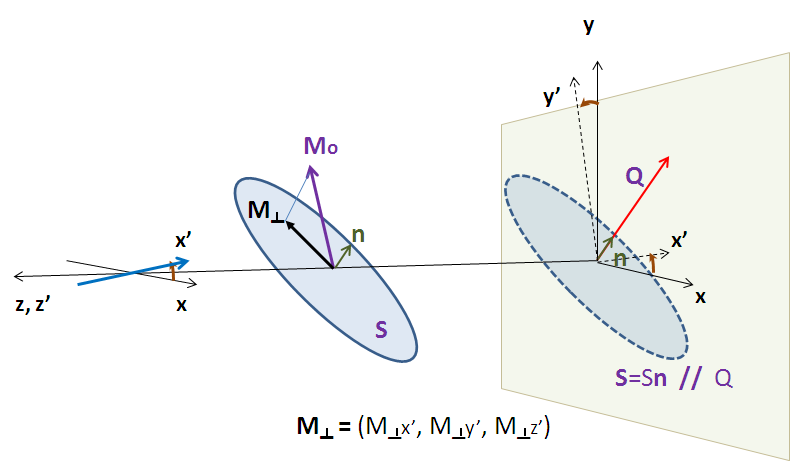Polarisation/Magnetic Scattering
Models which define a scattering length density parameter can be evaluated as magnetic models. In general, the scattering length density (SLD = β) in each region where the SLD is uniform, is a combination of the nuclear and magnetic SLDs and, for polarised neutrons, also depends on the spin states of the neutrons.
For magnetic scattering, only the magnetization component M⊥ perpendicular to the scattering vector Q contributes to the magnetic scattering length.

The magnetic scattering length density is then
where γ=−1.913 is the gyromagnetic ratio, μB is the Bohr magneton, r0 is the classical radius of electron, and σ is the Pauli spin.
Assuming that incident neutrons are polarized parallel (+) and anti-parallel (−) to the x′ axis, the possible spin states after the sample are then:
- Non spin-flip (++) and (−−)
- Spin-flip (+−) and (−+)
Each measurement is an incoherent mixture of these spin states based on the fraction of + neutrons before (ui) and after (uf) the sample, with weighting:
Ideally the experiment would measure the pure spin states independently and perform a simultaneous analysis of the four states, tying all the model parameters together except ui and uf.

If the angles of the Q vector and the spin-axis x′ to the x - axis are ϕ and θup, respectively, then, depending on the spin state of the neutrons, the scattering length densities, including the nuclear scattering length density (βN) are
and
where
Here, M0x, M0x, M0z are the x, y and z components of the magnetization vector given in the laboratory xyz frame given by
and the magnetization angles θM and ϕM are defined in the figure above.
The user input parameters are:
| sld_M0 | DMM0 |
| sld_mtheta | θM |
| sld_mphi | ϕM |
| up_frac_i | ui = (spin up)/(spin up + spin down) before the sample |
| up_frac_f | uf = (spin up)/(spin up + spin down) after the sample |
| up_angle | θup |
Note
The values of the ‘up_frac_i’ and ‘up_frac_f’ must be in the range 0 to 1.
Document History